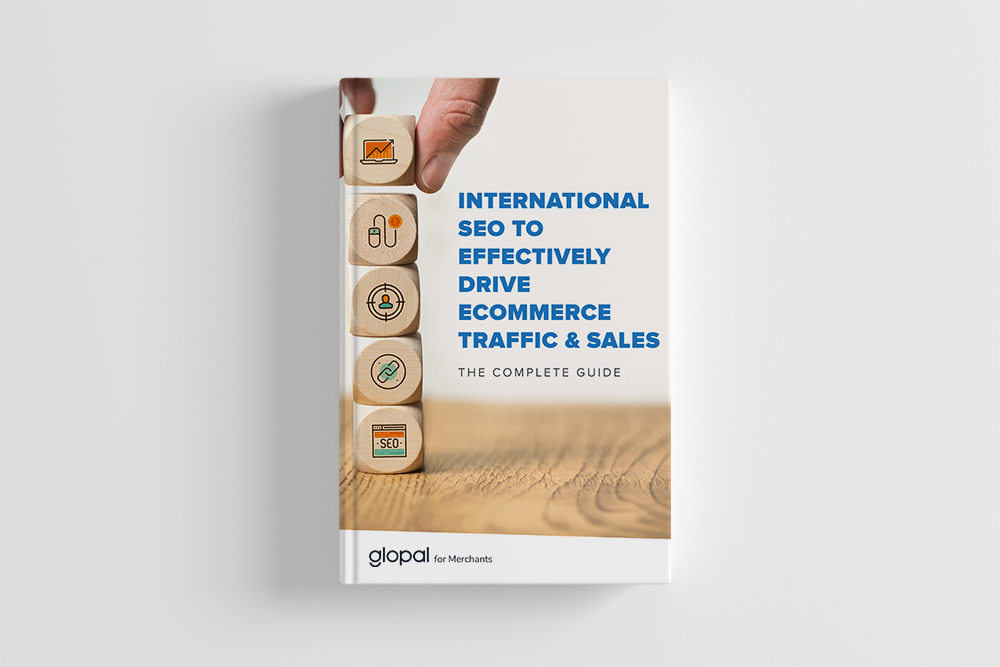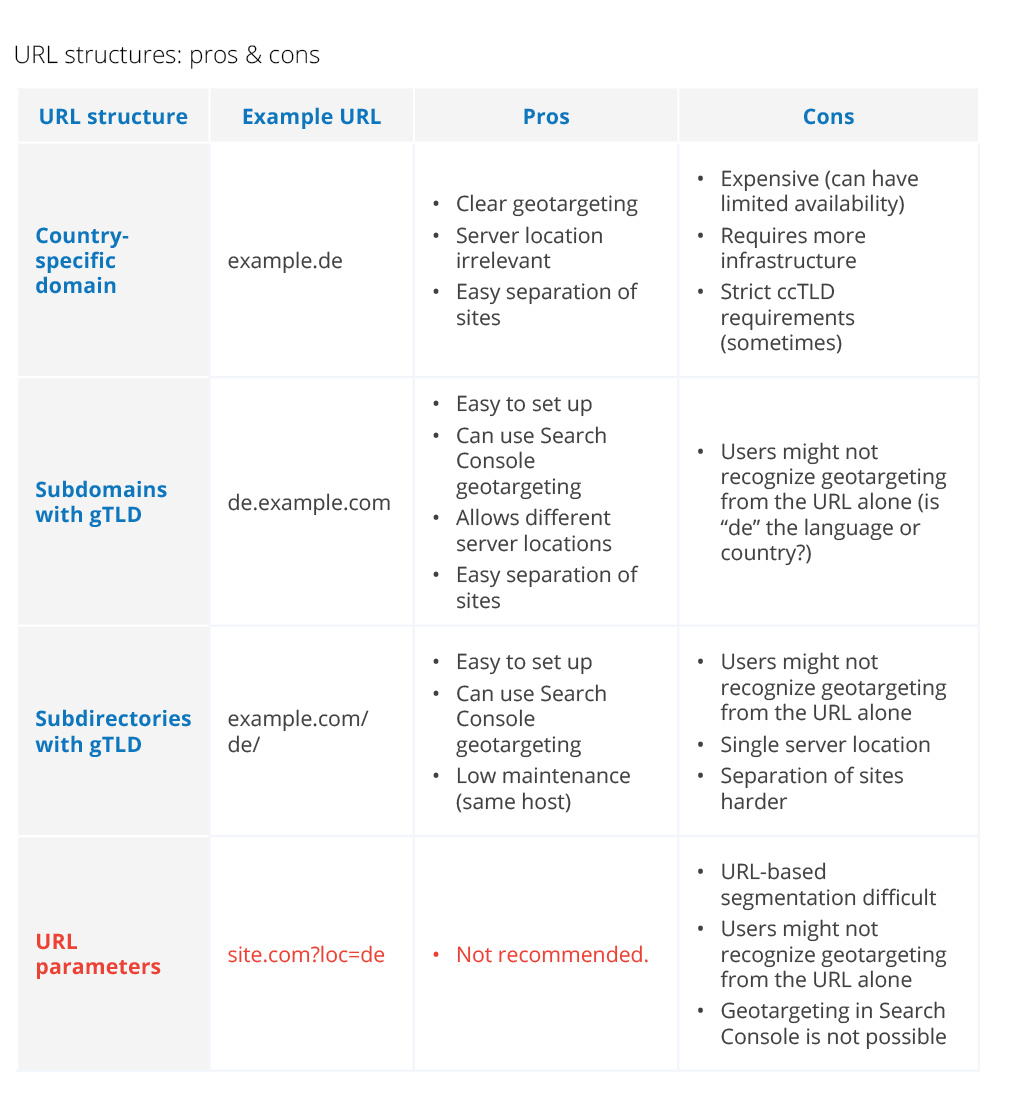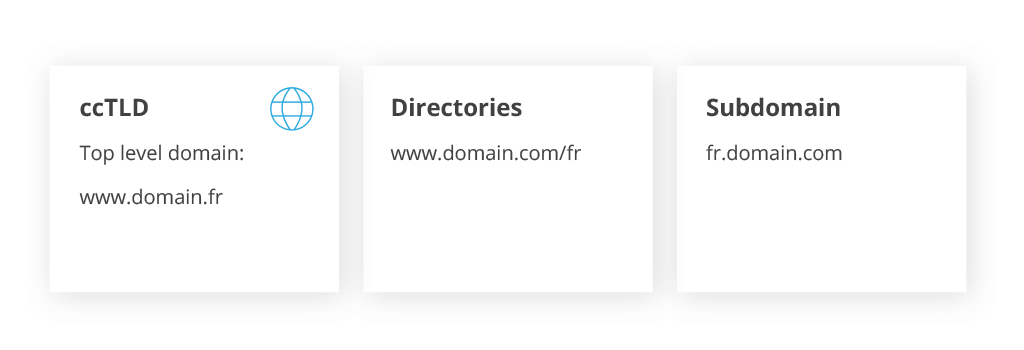When it comes to international SEO for ecommerce, choosing the domain structure for international online stores can be a complex decision. There’s no one-size-fits-all solution. Search engines may favor country-specific domains. However, developer teams may prefer the most convenient solution and vote for subfolders.
In this article you’ll read about international domain structures for ecommerce sites. You’ll learn how to choose the optimal structure for your store so you can target the correct location and maximize your global organic traffic.
This article will cover:
- ccTLDs (country code top-level domains), directories, subdomains & combinations of structures
- Language parameters & country selectors
- Pros & cons of each solution
- Practical recommendations and much more.

Interested in driving international traffic and conversions to your online store? Download our FREE ecommerce guide on international SEO for ecommerce.
International SEO & ecommerce: how to choose the international domain structure?
There are essentially three choices for setting up an international domain architecture: ccTLDs (country code top-level domains), directories/subfolders and subdomains. Regardless of the domain structure you select, stay consistent. Mixing different types of targeting and structures could mean you end up cannibalizing, competing with each other and generating more management complexity. If you decide to change your URL structure later, it’s likely to influence your rankings and cause a drop in traffic for a certain time period. It’s a complicated process in general so do all the necessary planning beforehand. Read on to find out more about each type of domain structure and its pros and cons.
What are ccTLDs (country code top-level domain)?
A country code top-level domain is when you migrate your website to a country-specific domain hosting. Instead of keeping a generic .com domain, you use specific country coded URLs, such as .de for a German version of your website or .es for a Spanish version. For example, TripAdvisor and Amazon are country-targeting using ccTLDs. Hosting a site on the .de domain will send the clearest signal that it’s content relevant for German-speaking searchers who want to see search results with German sites, thus signalling relevant content.
ccTLDs: pros
- Due to the specific country extensions, ccTLDs are the ideal structure to geolocate. Specific ccTLDs like .uk, .de, or .it are already geolocalized by default.
- As each country has its site, this option is good if you have specific offers and objectives for different countries.
- Addresses are easily understandable for Internet users and imply the connection to local countries.
- As a website with a .com domain could be based anywhere in the world, websites with country code top-level domains win out over competing brands using generic .com domains.
- If you have the financial and technical resources, consider using a ccTLD (Google states that it uses ccTLD to determine country targeting).
ccTLDs: cons
- ccTLDs require more effort and resources to grow their popularity from scratch as new and independent domains. This architecture can be the most complex and expensive to implement and maintain with a domain needed for every focus country. Therefore, using them is optimal for already well-known brands with large audiences in their target countries.
- While a .com domain can be purchased for approximately $10, some TLDs can cost more than $1,000 and require a local presence in the country. You may have to buy numerous domain names, which requires a larger budget and more complex management.
- Your brand may not be available as a domain name in every country and some countries impose constraints on purchasing domain names.
- Websites with ccTLDs mainly target the users located in certain countries so room for expansion is limited. Thus, it’s worth checking how your TLD choice will impact your ROI.
- Google won't transfer the page authority from the original domain to the translated one. This results in the fragmentation of the brand’s "authority" as it’s broken up into several sites and therefore much weaker for each site.
To help boost page authority for new domains, you can try to generate quality inbound links back to your website. For example, finding popular website and blog directories and generating the majority of inbound links from French users/directories to your domain (whether http://www.domain.fr or http://fr.domain.com) will notify search engines that French-based traffic should be funneled there appropriately. Finally, when migrating to a country-specific domain, your main site will lose the age and authority, which may affect your search engine rankings. Implementing a 301 redirection strategy before migration helps transfer your ranking and authority from your main site.
What are directories?
Directories follow the ".com" (or ".net" or ".org," etc.) generic top-level domain (gTLD). For example, If your domain is domain.com, you can add a folder called domain.com/german/ to target German language speakers or domain.com/uk/ to target UK users. Spotify and EA use directories for their country targeting and Skype and Atlassian use directories to language target.
Directories: pros
- Directories are optimal for businesses that have a lower volume of content, fewer resources and prefer to keep their maintenance costs at a bare minimum. There’s a single domain name to buy, which results in financial savings and simpler management.
- Directories are optimal if you have similar offers and objectives for all countries.
- Directories are effective when you want to make the most of your domain authority and backlink portfolio. With directories it’ll be easier to consolidate the popularity as a single entity under the domain (stronger "authority" for search engines).
- With this structure you’re constantly adding fresh content to your main site and giving search engines more links to crawl (your website ranks higher in search results).
- Directories make it easier to track a site’s performance in Google Analytics. That’s because the data for the whole primary site is in one place. In contrast, two or more domains mean searching two or more data points.
Directories: cons
- A directory implementation can be easy and inexpensive. However, it can be difficult for people to understand the location targeting from the URL alone.
- The complexity of the web structure associated with adding every subdirectory. The site must be geolocalized in the Google Search Console.
- It's just one site for Google; there’s no netlinking as the links between these sites will be internal.
What are subdomains?
If you want to keep your main website, subdomains become its division and allow you to target a specific audience and/or country. Subdomains are placed on the left-hand side of the main URL, e.g. shop.domain.com and news.domain.com are subdomains of .domain.com.; a UK targeted subdomain might be uk.domain.com; a French language version fr.domain.com. Wix and WordPress.com are language targeting using subdomains and Shop and Beats by Dre use subdomains to country target. A subdomain contains separate content and technically becomes a different website linked to the main website. It defines a larger part of the root domain and can be used to set up an ecommerce store, a blog or for language and geotargeting.
Subdomains: pros
- Subdomains are optimal if you need to index more content and don’t want to add an additional level of depth to your web structure.
- Subdomains are usually relatively easy to implement; there’s one domain name to buy.
- It may be a good solution if it’s complex to buy a domain name in a given country.
- One site means a stronger "authority" for search engines.
Subdomains: cons
- Like directories, it can be difficult for people to understand the location targeting from the URL alone.
- It's just one site for Google. The site must be geolocalized in the Google Search Console.
- It may require extra effort to develop the subdomains’ popularity as they’re usually seen more as independent entities. There’s conflicting evidence, but subdomain implementations may not share link authority with the content on the rest of the domain. This means that the links that come into your English subdomain wouldn’t help your German subdomain rank and the other way round.
- Subdomains may be misunderstood by some Internet users who are not used to them.
Combinations
To apply language targeting and geotargeting simultaneously, you will have to combine structures, e.g. a subfolder with a parameter or a subdomain with a subfolder. If you choose to use two subfolders in a row, always use the first subfolder for country targeting and the second folder for language targeting.
What are language parameters?
Language parameters are a scalable solution and easy for tagging. However, parameters will make each international web version more complex to optimize/track and they don't look that clean: “yoursite.com?lang=en-us” to target users that speak American English or “yoursite.com?loc=ca” to target users in Canada.

What are country selectors?
You can use the links that each country site gets to strengthen the authority for all country sites. Country and language selectors help to strengthen the network of backlinks that each country enjoys provided they’re crawlable. Ensure that in the header or footer there’s a country selector element that features a crawlable rollover or a dropdown element linking to the other major countries served. Consider linking to other sites with a country selector, not only to/from your home page. For example, from www.mysite.fr/product_A.htm you can link to www.mysite.de/product_A.htm or www.mysite.co.uk/product_A.htm. In the case of a large network of international sites, it’s important to keep user experience simple for most visitors. You can link only to the priority sites directly from the header/footer, which will funnel link authority between your highest priority sites. For access to the cast of hundreds, you can include a traditional sitemap of international sites.

Improve your international SEO with Glopal
Glopal helps you optimize your international SEO and drive more international traffic to your store. By translating and localizing your store content, we enable international search engines to index your content locally to your global buyers, maximizing your visibility and making the best use of international SEO. We improve your organic international traffic by localizing and optimizing your entire store’s SEO structure, including:
- Meta title and description translation
- H1 tags, h3 tags and image alt tags
- Hreflang attributes.
Contact us to find out how you can benefit from this service.
Sources








